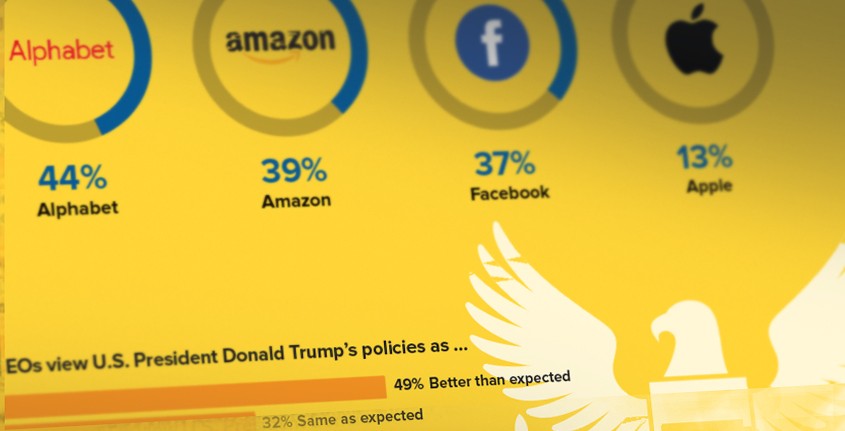Executives Take a Stand
When she took over The Washington Post in 1963, Katharine Graham became the first female head of a Fortune 500 company. More than 50 years later, just 24 of the CEOs running the United States’ largest 500 companies are women.
There is clearly a disconnect between the C-suite and the decades-long push for gender equality. But with the #MeToo movement drawing renewed attention to the obstacles women face at work, executives have an opportunity to enact lasting change, says gender, diversity and inclusion thought leader Deborah Gillis.
The hot-button issues executives are grappling with extend beyond gender equity. Employees and customers alike are increasingly expecting organizations to take clear stands on issues once viewed as falling outside the purview of business. “Whether on gun control, race relations, sexual harassment or immigration, these are sensitive issues, so navigating them is certainly challenging,” says Ms. Gillis, former CEO of Catalyst, a nonprofit that aims to advance and accelerate women in business around the world. She is now the president and CEO of the Centre for Addiction and Mental Health (CAMH) Foundation, Canada’s largest mental health teaching hospital and one of the world’s leading research centers in its field. IQ recently spoke with Ms. Gillis about how leaders can drive change while managing the risks that come along with sticking out their necks.
“There is a growing understanding that employees do not leave their personal identity or issues that they care about at home.”
—Deborah Gillis
IQ: How would you describe the state of gender equality in the workplace today?
Deborah Gillis: Frankly, it’s discouraging to see that women continue to face significant barriers to advancing through the pipeline. Women make up close to half of the workforce of S&P 500 companies, but men hold 95 percent of CEO positions in those companies.
IQ: Why do you think so many industries and organizations have been slow to change?
DG: It goes back to some pretty fundamental issues around unconscious biases and stereotypes. For example, the idea that women are good at the “take care” behaviors and men are good at the “take charge” behaviors typically associated with “leadership.” As those stereotypes and biases cascade through decisions made in organizations, they limit women’s opportunities to advance.
IQ: How can executives create more inclusive workplaces, and not just for women, but for all employees regardless of race, gender and sexuality?
DG: It starts with the tone at the top. Leadership teams must be held accountable for results and for documenting and communicating the business case for inclusion—not only in terms of financial performance but also reputational risk and competitive advantage in recruiting and retaining top talent.
IQ: Do you see the #MeToo movement and the heightened mainstream focus on gender parity driving a greater push for change than before?
DG: It’s changed the dialogue in a really fundamental way. We’ve had a significant wake-up call for anyone who may have been apathetic or had a point of view that these kinds of overt and blatant discriminatory behaviors don’t happen anymore.
On the flip side, there’s been conversation about whether there will be a chilling effect in workplaces in terms of, for example, men’s willingness to mentor or spend time alone with women. We need to come back to clarity around appropriate and necessary business relationships because we know that women need both mentors and sponsors to advance in their careers. Because the vast majority of leadership positions continue to be held by men, their support is critical.
IQ: How should executives ensure the changes or conversations occurring now will stay in place even after they leave an organization?
DG: Accountability for behavioral change needs to become baked into the way organizations run. We really need to see organizations focus on behavioral change that can be embedded within training and learning opportunities; reinforced through accountability mechanisms; and role-modeled and championed by leaders and organizations. If you have skin in the game, then you’re paying attention to these issues in a different way.
One of the issues that women have faced for so long is that you can’t be what you can’t see. If there are not leaders that serve as positive role models for other women, then it not only causes women to say, “I can’t be successful here,” but it’s a lot easier for some of these behaviors to go unchecked.
“Whether on gun control, race relations, sexual harassment or immigration, these are sensitive issues, so navigating them is certainly challenging.” —Deborah Gillis, former CEO of Catalyst, and current president and CEO of the Centre for Addiction and Mental Health Foundation
IQ: Beyond gender parity, what role should executives play in other issues, such as the gun control debate in the United States, immigration or Brexit?
DG: There’s a bottom-up demand for leaders to be proactively responding to some of these big societal issues on the minds of their employees. Some of the stories I’ve heard from CEOs about the kinds of conversations that they’ve engaged in—whether around race relations or gun violence or sexual harassment in workplaces—have signaled a transformation. They’ve opened up a whole new level of understanding and dialogue in workplaces and have created an attachment to the organization, its culture and values and leadership.
There is a growing understanding that employees do not leave their personal identity or issues that they care about at home. We need to create more inclusive cultures that acknowledge that people need to bring their full selves to work and that it, in fact, helps them to be more engaged and productive employees.
IQ: How do you see Starbucks vis a vis this dynamic? The company initiated organization-wide anti-racial bias training soon after the April arrests of two African-American men in a Philadelphia store who were sitting at a table without making a purchase.
DG: It’s a really good example of leadership quickly responding to the voice of customers and also the demand of employees. Both are asking, “What do you stand for?” If there is a gap between what leadership says it cares about, and the actions within that organization and what is tolerated, people notice.
IQ: Is that something that has come about in recent years or have leaders always had that role to play? How do you expect that role to evolve?
DG: It’s accelerated, and I don’t believe that it’s something that we can turn back from. Look at generational shifts in society and the increasing diversity among employees. The demand from those employees for more inclusive workplace cultures and greater transparency and communication about inclusivity is going to continue. The most successful businesses, in terms of their ability to recruit and retain the best talent, will be tied very much to the employees’ perceptions of opportunities and the culture within organizations.
IQ: How can executives mitigate the risks of navigating social change debates?
DG: Leaders should frame their interventions in ways that connect back to business strategy and results, and to creating healthy and inclusive workplaces. These issues are so closely tied to talent management, to the people issues that are the key driver of business success.
IQ: What do you see as some of the emerging social issues that organizations and executives will have to address?
DG: In my current role as the president and CEO of CAMH Foundation, I see a need for greater attention to issues of mental health and wellness in the workplace. It’s not often talked about by business leaders in a public way. Yet the statistics show us the significant numbers of citizens and employees facing issues around mental health. We need to think more expansively about how we talk about this issue to ensure that stigma does not hold us back from having these important conversations.
Leaders’ championship of lesbian, gay, bisexual, transgender, questioning or intersex (LGBTQI) dialogue in workplaces has made it easier for employees to come out in the workplace. Being open and transparent and demonstrating leadership around these conversations can fundamentally shift how someone feels about whether they can be open.
Too many people view it as some kind of weakness to admit they are facing mental illness and need help. In a workplace culture focused on results and performance, what are the behaviors that are rewarded? It can be really difficult for people to come forward. Talking about mental health openly can have a transformative impact on the health and wellbeing—and, therefore, the productivity and engagement—of employees.
IQ: Are you encouraged that companies are changing?
DG: When I think about gender equality, I am encouraged by the fact that the conversation over the last 10 or 15 years has shifted from, “Convince me why we should be paying attention to gender equity issues in workplaces,” to, “Help me understand how to accelerate progress.” That’s a really important shift.
The second shift that is taking place, and that really needs to accelerate, is to move from programmatic activities, such as creating a program to support women or a mentoring program, to a fundamental shift where inclusion becomes a core value and culture of the organization. It is not just the job of human resources or leadership to care about and pay attention to inclusion. It is fundamentally the responsibility of everyone who works in a company, because it is so vital to the ultimate success of a business.




